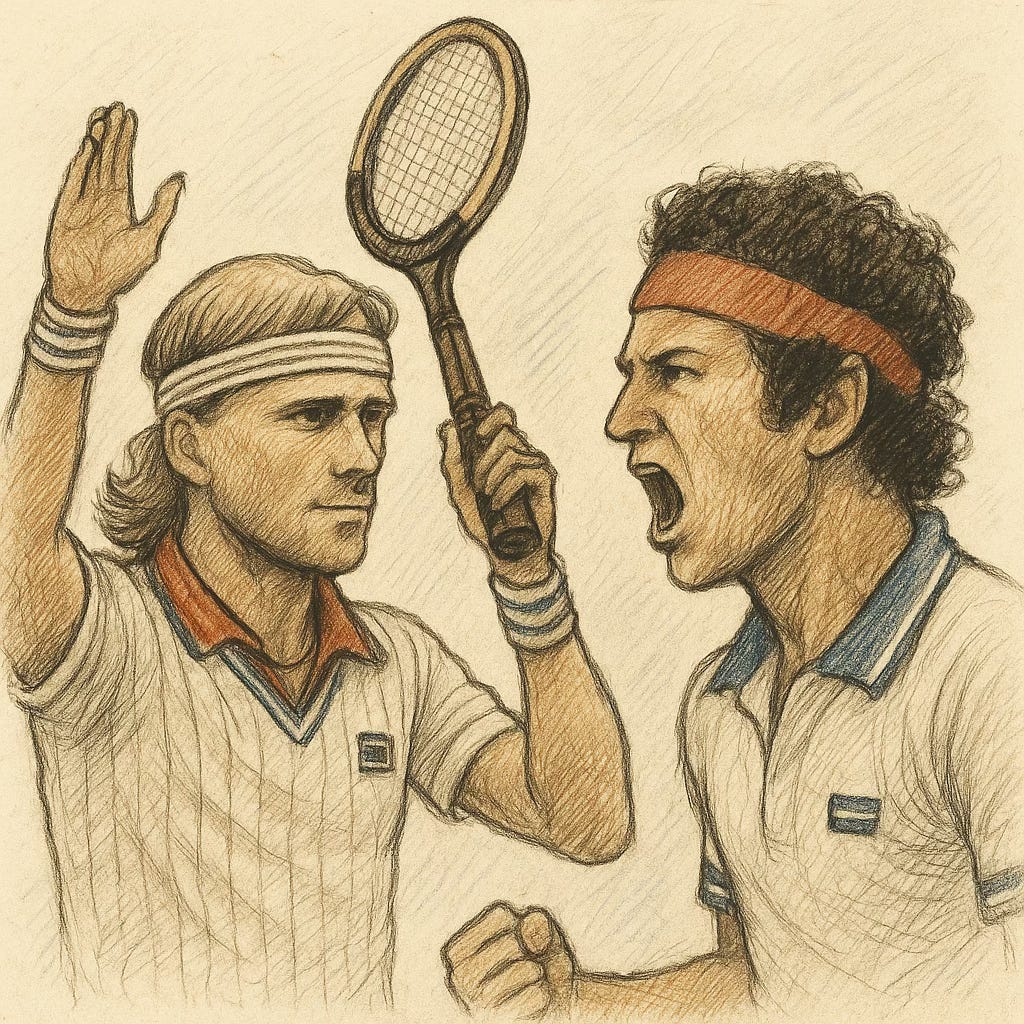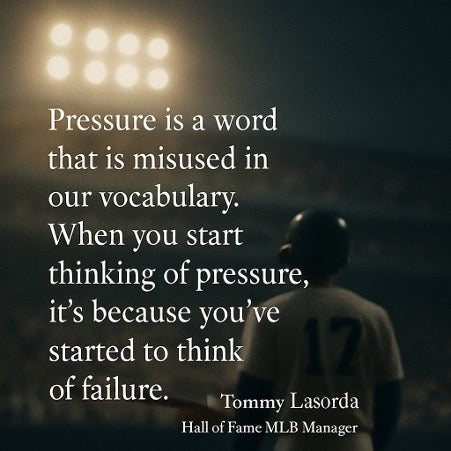
The Ice and the Fire
The Ice and the Fire: Borg, McEnroe, and the Lessons of Composure
The match that revealed two very different paths to greatness.
Act 1 – The Ice Man Alone
There are moments in sport when a single figure can hold thousands in a kind of spell. No words, no gestures, no theatre — just the quiet assertion of presence. Björn Borg had that power.
When he walked onto Centre Court, the atmosphere changed. The noise softened, the air seemed to still. He was only in his early twenties, yet he carried himself as if he were carved from something older and deeper, a monument disguised as a man. The long hair, the headband, the unflinching gaze — he looked like a rock star who had wandered into a cathedral, and somehow the cathedral belonged to him.
What was remarkable was not just the way he played, but the way he didn’t perform. He never sought the crowd’s approval. He never pleaded with umpires. He never betrayed to an opponent the flicker of frustration or doubt. Every point — whether won with brilliance or lost on a miss-hit — was met with the same ritual: turn, walk, breathe, adjust, begin again.
It was as if Borg had stripped competition back to its barest elements. No emotion wasted, no energy leaked. Where others fought the match in two arenas — one inside their head and one on the court — Borg fought only one. The silence became his weapon.
For the crowd, this stillness was mesmerising. They leaned forward, straining to catch something, anything, of his inner world. But Borg never gave it to them.
“He silenced a stadium without speaking.”
And that silence was not absence — it was presence. It told his opponents, You cannot touch me. It told the audience, You are here to witness, not to sway me. It told the sport, This is what mastery looks like.
He was nicknamed the Ice Man, but that makes him sound cold. He wasn’t. He burned with competitive fire, but he never let you see the flames. His genius was to turn restraint into theatre — to make silence louder than noise.
Insight: Borg showed that composure itself can be performance — silence as power, restraint as theatre.
Act 2 – The Volcano Across the Net
If Borg was silence, then John McEnroe was sound. Where the Swede drew crowds into stillness, the American dragged them into theatre. He was fire, friction, and fury — sometimes all within a single point.
From the moment he appeared on tour, McEnroe seemed to test the boundaries of tennis itself. The lines weren’t just chalk on grass or clay; to him, they were provocations. Every close call was a spark. Every umpire became a stage partner. Every crowd, a jury. He didn’t so much play in silence as conduct an orchestra of outrage.
Where Borg’s headband became a halo of discipline, McEnroe’s hair frayed like the electricity around a storm. His gestures were wild, his voice carried through the stadium, and his face told the story of every point: anger, disbelief, triumph, exasperation. Nothing was hidden. Nothing was contained.
And yet — behind the tantrums, there was genius. The touch at the net, the artistry of the volley, the fearless improvisation. He could dismantle opponents with creativity as much as with confrontation. The crowd came not just to watch him win or lose, but to feel the unpredictability of his presence. With McEnroe on the court, anything might happen — and usually did.
“McEnroe unsettled opponents by offering too much.”
Borg unnerved opponents by offering no reaction. McEnroe unsettled them by offering too much. It was impossible to know which explosion was real and which was theatre, and perhaps even McEnroe himself didn’t know. But it worked: he forced players into his emotional weather, made them play not just against him but against the storm he created.
This was the paradox of McEnroe. His volatility cost him matches, but it also made him immortal. Where Borg had made silence eloquent, McEnroe made chaos unforgettable.
“If Borg was a glacier, McEnroe was a volcano.”
Together they formed a fault line in the sport — two archetypes colliding, shaping not just matches but the very identity of tennis itself.
Insight: McEnroe proved that passion, even when messy, can be unforgettable — fire leaves a mark where ice cannot.
Act 3 – The Match of Matches
There are matches, and then there are moments that slip into mythology. The 1980 Wimbledon men’s final is one of those. For four hours, Centre Court became an amphitheatre, and tennis became more than sport. It became silence versus sound, poise versus passion, Borg versus McEnroe.
Björn Borg entered as the four-time defending champion, 24 years old and already a legend in motion. He had not lost at Wimbledon since 1975. Across the net stood John McEnroe, 21 years old, brash, brilliant, and already notorious. The establishment disdained him, the crowd distrusted him, but he was fearless enough to take on the untouchable Swede.
What unfolded that afternoon was not just a contest for a trophy. It was a clash of philosophies.
The Early Exchange
McEnroe started like fire. He took the first set 6–1, his hands soft at the net, his angles cruel. Borg looked flat, almost distracted. Yet his face revealed nothing. He adjusted his headband, walked back to the baseline, and resumed his rhythm. No panic, no outward sign that the king of grass was under siege.
Then the balance shifted. Borg found his length, found his patience. He took the next two sets, 7–5, 6–3, grinding McEnroe down point by point. The baseline became his fortress, the rallies extended, the crowd settling into his silence. By the third set, Borg seemed inevitable, like a tide pulling the match in his direction.
But McEnroe was not done. He was too volatile, too combustible, to fade quietly.
The Tiebreaker of Tiebreakers
The fourth set went to a tiebreak, and what followed is still spoken of as the greatest sequence in the sport’s history: a 22-minute, 34-point drama that electrified the stadium.
Borg reached match point five times. Each time, McEnroe stared down the abyss and swung. He served with venom, volleyed with audacity, covered the net like a man possessed. The crowd, who had booed him only days earlier, now gasped and cheered with every save.
And Borg? He never flinched. Not once. Not when his backhand clipped the tape and fell wide. Not when McEnroe conjured impossible volleys. Not when the set, and the match, slipped from his grasp. He betrayed nothing — no groan, no sag of the shoulders, no glance to the heavens. The camera searched his face for signs of doubt and found only the same blank serenity.
Finally, at 18–16, McEnroe forced the match into a fifth set. He raised his arms, roared at the crowd, his chest heaving. Borg walked calmly to his chair, sat down, and quietly towelled his face.
“Silence endured where noise could not.”
It was here, in that pause, that the contrast became real. McEnroe had spent everything just to survive. Borg had revealed nothing, and in that silence he told the crowd: I am not done.
The Fifth Set
The final set began with the stadium holding its breath. Every serve, every rally felt loaded with history. McEnroe surged, holding his serve with clenched fists and clenched teeth. Borg absorbed, absorbed, absorbed. His returns were relentless, his eyes unchanging.
At 6–5, Borg broke. It was almost anti-climactic — a couple of errors, a couple of clean winners, and suddenly he was serving for the match. The crowd sensed the weight of it: five straight Wimbledons within reach, against the one man wild enough to challenge him.
Borg’s first match point arrived. A rally unfolded, McEnroe lunged, but the ball flew long. It was over. Borg had won, 8–6 in the fifth.
And then — only a brief drop to his knees, a flicker of release. No triumphant scream, no prolonged celebration. Borg quickly rose, placed his racquet down, raised his arms once, and walked forward to shake McEnroe’s hand. It was his 41st consecutive Wimbledon win, his fifth title in a row, one of the greatest feats in tennis history. And he carried it like it was nothing more than another day’s work.
The Psychology of Silence
What made that final immortal was not just the quality of the tennis, though it was sublime. It was the contrast in character. McEnroe had played one of the greatest sets ever witnessed, clawing back from the brink, and yet it was Borg’s composure that decided the match.
In that fifth set, Borg showed no scars from the fourth. Most men would have been broken by losing such a tiebreaker — the weight of squandered match points, the momentum of the crowd shifting. But Borg seemed untouched. His silence became a shield, his stillness a declaration: I am immune to what just happened.
McEnroe, for all his genius, was spent. His emotion had carried him through the fire, but it had also drained him. Borg’s calm had conserved him. In the end, silence endured where noise could not.
Insight: Their 1980 final revealed the deeper truth: in the long run, calm endures, while chaos burns bright and fast.
Act 4 – The Legacy Across Decades
If Borg and McEnroe represented silence and sound in perfect collision, then the decades since have been an extended echo of that contrast. Every generation of champions has seemed to stand somewhere along the spectrum between the Ice Man and the Volcano.
Federer: Composure as Art
Roger Federer embodied Borg’s lineage. He was elegance and economy, a man who seemed to float through matches with a calm so refined it bordered on aesthetic. Where Borg was granite, Federer was silk — but the principle was the same. Never let the world see you fracture.
Federer’s composure was not just restraint, it was strategy. It told opponents: you cannot touch me, not even with your chaos. Even in his most desperate moments, he remained a figure of grace, a man who turned tennis into ballet. Like Borg, his silence was a form of communication. It said: This is under control.
Nadal: Ritualised Resilience
Rafael Nadal carried a different shade of Borg’s composure — not stillness, but ritual. The towel, the bottles lined up just so, the endless bounce-bounce-bounce of the serve routine. Outsiders saw superstition; Nadal saw structure.
Nadal did show emotion — the fist pumps, the roars — but they came at carefully chosen moments, never as outbursts, always as punctuation. His genius was the ability to channel fire into discipline, to burn without losing control. In that sense, he was Borg with sparks.
Djokovic: Walking the Fault Line
Novak Djokovic is perhaps the closest thing to a bridge between Borg and McEnroe. At his best, he is an Ice Man: clinical, unreadable, absorbing pressure with uncanny elasticity. But beneath that calm lies volatility. He has erupted at umpires, torn shirts from his chest, fed off confrontation with crowds.
And yet — it is his composure, not his volatility, that has been the engine of his dominance. He can live with both masks, but when history is measured, it is the cold consistency, not the fire, that has carried him to more Grand Slam titles than any man before him.
Serena: Emotion as Power
Serena Williams belongs to McEnroe’s side of the lineage. Her greatness was entwined with her passion — the roar after a winner, the glare across the net, the visible intensity of her will. For Serena, emotion was not a weakness but a weapon, a way of bending the atmosphere to her favour.
She is proof that fire, when fused with focus, can fuel dynasty. Unlike McEnroe, who sometimes combusted, Serena controlled her blaze. Her emotion inspired as much as it intimidated. She showed that theatre and greatness can coexist when discipline frames the fire.
Kyrgios: Fire Without Anchor
Nick Kyrgios is brilliance in its rawest form. Mercurial, gifted, and unpredictable, he can summon shots of such audacity that they leave crowds gasping. His presence is magnetic not only because of the tennis he plays, but because of the sense that with him, anything might happen.
And yet, the question lingers: what if that fire were steadied by the composure of a Borg? Could such opposites ever coexist — or does Kyrgios’s genius depend on its volatility? Perhaps that is the essence of his fascination. He shows us that greatness is not only about trophies or dynasties, but also about the theatre of possibility, about fire untamed.
And it was never only the men. Chris Evert carried her own version of Borg’s composure, while Martina Navratilova brought fire and flair that reshaped the women’s game. Monica Seles, Venus Williams, Maria Sharapova — each added new shades of the spectrum. The details differ, but the pattern is the same: every generation finds its place along the fault line Borg and McEnroe carved. Ice and fire. Silence and passion. The archetypes endure.
Pickleball and Padel: New Fault Lines
Even in the new racquet frontiers of pickleball and padel, the same archetypes are re-emerging.
In pickleball, Ben Johns plays with Borg-like calm — analytical, unflappable, absorbing pressure until opponents crack. Across the net, Tyson McGuffin thrives on theatre, fist-pumping and feeding off the crowd, a fire closer to McEnroe’s. And in Anna Leigh Waters, still a teenager, we glimpse Serena’s lineage — fierce, fearless, emotion harnessed as fuel.
In padel, now the fastest-growing sport in Europe, the same dynamic often defines the best pairs. One player acts as anchor, steady and composed; the other as spark, daring and emotional. Balance between ice and fire often proves decisive.
Even legends have stepped across to these new courts. Andre Agassi and Steffi Grafhave both taken up pickleball and padel, carrying their aura into fresh arenas and showing that the old rivalries and rhythms still echo in new forms.
“Wherever a net divides opponents, the language of silence and fire returns.”
Insight: Every champion since has chosen a place on the spectrum — ice or fire, composure or passion. The archetypes live on.
Act 5 – Did They Change the Sport Forever?
When we look back at the Borg–McEnroe years, it is tempting to see them as simply a rivalry. But they were more than opponents. Together they shifted the language of sport itself.
Before Borg, silence was often mistaken for passivity. He proved it could be power. His calm became a kind of theatre — an act of restraint so compelling that it silenced stadiums and unnerved opponents. He professionalised composure, showing that greatness could be carried with dignity, without spectacle.
Before McEnroe, emotion was often dismissed as weakness. He proved it could be fuel. His fire made matches unforgettable, brought audiences to their feet, and reminded the sport that passion has a place in performance. He made theatre part of the modern game, forcing tennis to accept not only artistry but personality.
Between them, they expanded what it meant to be a champion. One showed how to lead by withholding, the other by expressing. One commanded respect, the other demanded attention. Both changed the sport forever.
What This Means for Us
As leaders, we face the same choice. Do we steady the room with calm presence, or ignite it with visible passion? Do we hold silence, or do we speak fire?
- Borg teaches us the strength of composure. In moments of crisis, the leader who stays steady gives others the courage to follow.
- McEnroe teaches us the value of emotion. In moments of inertia, the leader who shows fire can spark movement, even rebellion.
- Together they teach us that leadership is not one mask, but two — and wisdom lies in knowing which to wear.
Churchill in the Blitz was Borg: steady, immovable, giving people courage by refusing to crack.
Martin Luther King was McEnroe: fire as fuel, moving a nation through visible passion.
The lesson is not which is better — but which is needed.
The Lasting Image
The image of Borg raising his arms after the 1980 final — calm, composed, almost indifferent to history — endures not because it was loud, but because it was quiet.
The image of McEnroe raging at an umpire endures not because it was polite, but because it was raw.
Silence and sound. Ice and fire. Both immortal.
Greatness lies not in choosing one or the other, but in mastering the courage to be what the moment requires.




